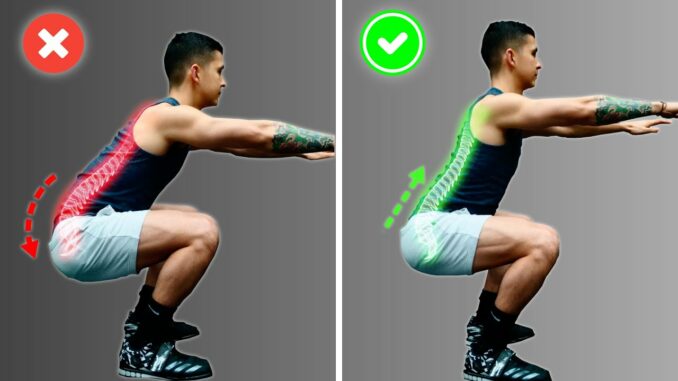
Introduction: The squat is often hailed as the king of exercises, and for good reason. It’s a compound movement that engages multiple muscle groups simultaneously, making it an essential component of any strength training routine. However, performing a proper squat requires more than just bending your knees and lowering your body. In this comprehensive guide, we’ll explore the intricacies of the squat, from correct form and technique to variations and progressions, ensuring that you can perform squats with confidence and efficiency.
Understanding the Basics: Before delving into the specifics of proper form, it’s crucial to understand the primary muscles targeted by squats. The squat primarily works the quadriceps, hamstrings, glutes, and lower back, with secondary involvement from the calves and core muscles.
Perfecting Form:
- Starting Position: Stand with your feet shoulder-width apart or slightly wider, toes pointed slightly outward. Keep your chest up, shoulders back, and core engaged to maintain a neutral spine.
- Descent: Initiate the movement by pushing your hips back and bending your knees, as if you’re sitting back into a chair. Lower your body while keeping your chest up and your weight on your heels.
- Depth: Aim to lower yourself until your thighs are parallel to the ground or slightly below, ensuring that your hips descend below the level of your knees. Avoid going too low if it compromises your form or causes discomfort.
- Ascent: Drive through your heels and extend your hips and knees simultaneously to return to the starting position. Keep your chest up and maintain a controlled movement throughout.
- Breathing: Inhale as you lower yourself into the squat and exhale as you push back up. Focus on maintaining a steady breathing rhythm to optimize performance and stability.
Common Mistakes to Avoid:
- Knee Valgus: Allowing your knees to cave inward places excessive strain on the knee joints and increases the risk of injury. Keep your knees in line with your toes throughout the movement.
- Forward Lean: Leaning too far forward shifts the emphasis away from the lower body muscles and can strain the lower back. Keep your chest up and maintain an upright torso throughout the squat.
- Shallow Depth: Failing to descend to an adequate depth limits the effectiveness of the squat and reduces activation of the targeted muscles. Focus on achieving full range of motion while maintaining proper form.
- Heel Lift: Lifting your heels off the ground shifts your weight forward and destabilizes the movement. Keep your weight on your heels throughout the squat to maintain balance and stability.
- Rounding the Back: Allowing your lower back to round places undue stress on the spine and increases the risk of injury. Maintain a neutral spine by keeping your chest up and your core engaged throughout the movement.
Progressions and Variations: Once you have mastered the basic squat, you can challenge yourself further by incorporating variations and progressions into your routine:
- Goblet Squat: Hold a kettlebell or dumbbell at chest level while performing squats to increase resistance and core engagement.
- Front Squat: Rest a barbell across the front of your shoulders, with your elbows pointing forward, to emphasize quad and core activation.
- Sumo Squat: Widen your stance and point your toes outward to target the inner thighs and glutes.
- Pistol Squat: Perform squats on one leg while extending the other leg in front of you, challenging balance and unilateral strength.
- Box Squat: Lower yourself onto a box or bench before standing back up, focusing on control and eliminating momentum.
- Overhead Squat: Hold a barbell or weighted object overhead while performing squats to improve shoulder mobility and stability.
Incorporating Squats Into Your Fitness Routine: Squats can be integrated into a variety of workout routines, whether you’re aiming to build strength, increase muscle mass, or improve athletic performance. Here are some tips for incorporating squats into your fitness regimen:
- Frequency: Aim to perform squats at least two to three times per week to see improvements in strength and muscle development.
- Sets and Repetitions: Start with 3-4 sets of 8-12 repetitions, focusing on maintaining proper form and control throughout each set. Adjust the weight and repetitions based on your individual goals and fitness level.
- Progressive Overload: Continuously challenge yourself by increasing the weight, repetitions, or difficulty of the squat variations you incorporate into your routine.
- Supersets and Circuits: Pair squats with complementary exercises such as lunges, deadlifts, or calf raises to create a comprehensive lower body workout.
- Rest and Recovery: Allow adequate rest between squat sessions to allow your muscles to recover and adapt to the stress of the exercise. Listen to your body and avoid overtraining to prevent injury.
Conclusion: Mastering the squat requires dedication, patience, and attention to detail. By focusing on proper form, avoiding common mistakes, and incorporating variations and progressions into your routine, you can unlock the full potential of this fundamental exercise. Whether you’re a beginner starting out or an experienced lifter looking to take your workouts to the next level, the squat offers a versatile and effective way to build strength, improve mobility, and enhance overall fitness. So, next time you hit the gym or work out at home, remember to incorporate squats into your routine and watch as your lower body strength and muscle development skyrocket.